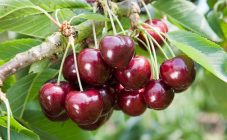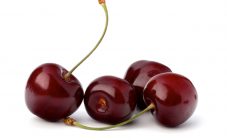Content:
Belarusian breeders, taking the best qualities from the cherry varieties Pobeda and Severnaya, have developed a new hybrid. They named it - Syubarovskaya cherry, in honor of one of the scientists who took part in the breeding development. The variety was registered in the first five-year period of our century and since then has enjoyed undeniable popularity in many regions of the Republic of Belarus.
Characteristic
The advantages of Syubarovskaya cherry description and comparison of varieties are revealed in detail.
Syubarovskaya cherry is a vigorous, high-yielding, winter-resistant variety. Distinctive features of the tree:
- height - about 2 m;
- the root system is well developed and does not sprout;
- branches are straight, branched;
- leaves are dark green, oblong, 1.5 cm long, pointed, with veins;
- flowers are white, collected in umbrellas;
- dense, lush crown is formed in the form of a pyramid
At maturity, the tree is dotted with many bright fruits that look like this:
- medium size, weight 5-6 g;
- the shape is heart-shaped, the tip is elongated, rounded, closer to the stalk, the shape expands;
- the bone is small, cordate;
- color - burgundy and maroon;
- soft, tender pulp, red juice
- the skin is dense, glossy, with shine;
- the taste is sweet, refreshing.
Fruit buds are laid in flower branches on a tree that is 3-4 years old.
The Syubarovskiy variety refers to early ripening, blooms when the air warms up to 15. The berries ripen gradually, ending with juice at the end of June, under favorable conditions up to 20 kg of fruits can be harvested from one tree. Reproduction - by seeds and cuttings.
The tree is self-fruitless, for pollination it is required to plant related species nearby: Narodnaya, Severnaya, Gronkovaya. The best pollinator is the Gronkovaya cherry.
Description of cherries Gronkova
Sweet cherry Gronkovaya was bred by Belarusian breeders by mixing the pollen of common and Northern sweet cherry, registered at the very end of the last century.
Characteristics of the variety:
- high frost resistance;
- has an average height, an adult tree grows up to 5 m;
- straight branches, medium thickness, brown;
- leaves are elliptical, dark green, small;
- the crown is dense, wide, pyramidal;
- fruits weighing 5g, bright red, sweet, soft;
- the bone is small, heart-shaped, easily detached.
This variety of sweet cherries gives the first harvest 4-5 years after planting the seedlings.
Gronkova's productivity is high, more than 8000 kg of delicious berries are harvested from 1 hectare annually. The first fruits are harvested in June. The tree is self-fertile, it must be pollinated with related varieties: Syubarovskaya, Zhivitsa, Narodnaya, Iput.
Growing features
Syubarovskaya cherry is especially fruitful if the tree is planted on low slopes, hills, with good air drainage. Such places are well warmed up by the sun, which means that the berries will be as sweet and aromatic as possible.
It is important to provide protection from winter gusty winds. In the winter months, more snow is scooped up to the trunk of the tree - gradual spring moisture is important for it.For this, low-growing shrubs are also planted near the tree.
The tree does not like high soil moisture, a high content of peat and clay is also not suitable for cherries. Syubarovka takes root well and bears fruit in those places where the soil contains limestone and sandy layers. The acidity of the soil should not exceed 7.
Sapling planting rules
It is undesirable to plant cherries in the fall, the seedling may not tolerate frost. Syubarovski begins planting in the spring, when the snow melts and the top layer of the earth warms up slightly.
Before planting, the soil must be fertilized with organic matter. To do this, remove the layer of earth where the sweet cherry will grow, mix it with mullein, humus, superphosphate and wood ash. They return the mixture to its place, dig a hole in it 50-60 cm deep, 70-80 cm in diameter.The level of the humus layer should be 15-20 cm.
Damaged, dry, weak roots are removed from the root part. Landing is carried out in two ways:
- with a clod of earth;
- no coma.
Carefully place the seedling in the hole, cover it with the remaining earth, shake it slightly. This will help the soil to spread evenly between the roots.
With an earthen lump, cherries are planted in the same way, but the plant is taken out of the planting pot along with the earth and quickly moved into the prepared hole.
Then the earth is tamped, a circular border is formed from it around the tree so that water does not spread during watering. A bucket of water is poured under the root of the seedling. Each subsequent tree is planted at a distance of 4-5 meters from each other.
Crown formation
Syubarovka is distinguished by the rapid growth of shoots for the first 4 years. Therefore, it is necessary to prune branches annually. Do this before the buds swell, in early spring.
To form a crown, those branches that are knocked out of the general picture are cut off.
Branch pruning rules:
- the branches that form the crown are cut to 5 m long;
- those that do not affect the formation should be no more than 50 cm;
- for the formation of branches of the semi-skeletal type, the shoots are shortened to 60 cm.
After pruning, the Syubarovskaya cherry begins to gum, so the wounds on the tree are treated with special garden glue.
A correctly formed crown of a young seedling looks like this:
- stem - 60 cm high;
- conductor - 4 branches, the distance between them is 60 cm;
- two tiers of branches, each with 4-5 pieces, at a distance of 50 cm from each other.
Throughout the summer, strong lateral shoots up to 3 leaves are removed with pruners. Branches are cut annually, overlapping each other, limiting the access of sunlight to the central part of the cherry.
Care
Caring for the tree is simple, you just need to water and fertilize it. Watering should not be too abundant, otherwise the quality of the fruit will suffer. Fertilizer is used twice, in autumn and early spring, in small quantities. Simultaneously with watering, it is necessary to loosen the ground around the tree and remove all weeds.
Disease protection
Adult plants of Syubarovka do not get coccomycosis - breeders have instilled in the plant resistance against it. And young ones who have not gained strength can get sick.
Diseases affecting cherries:
- aphid - the affected plant is depleted and dies;
- clasterosporium - destroys leaves, buds, flowers;
- moniliosis - causes drying of inflorescences and rotting of fruits.
Having noticed signs of the disease, the affected areas should be removed, treated with herbicides, following the instructions. After harvesting, it is imperative to carry out a comprehensive treatment of the tree, combining fungicides and insecticides.
Advantages and disadvantages
Syubarovskaya cherry is a hybrid, practically devoid of flaws.
Pros:
- consistently high yield;
- early ripening variety;
- grafted resistance to certain diseases;
- excellent taste;
- tree is a long-liver.
Minuses:
- a related cherry pollinator is required;
- does not tolerate high humidity;
- requires a certain soil composition.
Sweet cherry is the earliest fruit. After winter avitaminosis, cherry juice will enrich the human body with essential vitamins and microelements. A tree covered with snow-white flowers will decorate the spring garden.














